Victoria Hancox's Blog
February 16, 2023
Choose Your Own Writing Strategy Tip #6: Putting It All Together AKA Where Do I Even Start?
This starts with a disclaimer that the process described here is my way. It’s not necessarily a good way; it’s not even a way I follow with each book, and it definitely won’t be everyone’s cup of tea. But it is a starting point. Something to try out, then you can keep the bits that worked and try new bits that you’ve gleaned from other people. So, here goes my 8-step process!
Step 1: Assemble the Nuts and Bolts
The general idea of the story should be established first, otherwise, you’ll go nowhere fast. By answering these questions, the world that you are creating should start to take shape. Grab a notebook and scribble some notes.
Characters Who is the protagonist? What are they like? Why are they in this situation? What do they want to achieve in this? Who is the nemesis/nemeses? What is thwarting the protagonist? Is it a living thing or a situation or something else? What do they want to achieve? Why are they doing what they are doing? Who are the ‘helper’ characters and why are they against the nemesis? Who are the additional threats? Who are you in danger from in the run up to meeting the nemesis? Plot devices How does the protagonist succeed in the end? What are the fixed stepping stones that get the reader to the end? What midstory/mini-achievements must be made? For example, finding a new location, destroying a machine, killing a low-level adversary Location Where is this taking place? Can you picture it? Can you list a number of rooms/areas within this location? Is it based on anywhere real?Once you have these facts scrawled down, move onto the next step.
Step 2: Pin It Down
Start with the big picture — put your plot devices in place, and I mean that literally! I use pieces of A3 paper, so, for example, Nightshift would look like:

It doesn’t look much, but this is the basic skeleton of the story, and now you can hang the flesh on those bones. But what does that look like?
Take ‘kill nemesis’ — and here, I will use imaginary things, so as not to spoil Nightshift!
What information and/or objects will be needed to kill the nemesis? Let’s say you decide that Item A, password B, and location C are all essential for this murder.
For each of those, you then need to decide where and how these are acquired. We’ll focus on the first object and say that Item A is found in a safe behind a painting in a study. That’s a lot of information and could be broken down further:
Item A is a dagger The dagger is kept in a safe The safe is behind a painting in the study The combination to the safe A good opportunity for a puzzle to reveal the combination The description of the painting “The dagger is behind Lady Penelope” and later, the description of the study refers to a portrait of Lady Penelope Where the study is located If it is in a secret or hidden location, how do you reach it?
This can go even further by having someone reveal that person X knows where the safe is located, but they’ll only tell you if you give them some chocolate. Now, you have to find person X AND chocolate…
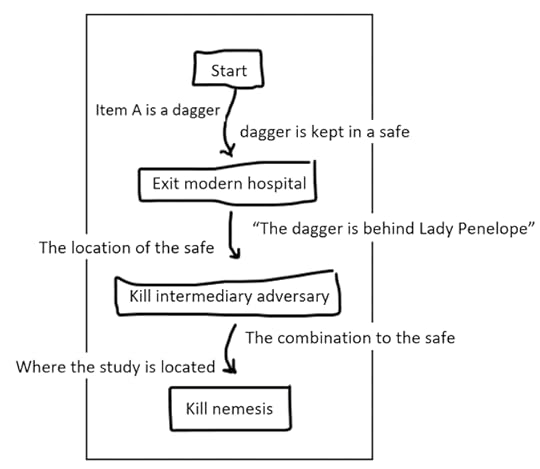
As you can see, this could go on and on, but you can keep it short at this stage, especially if you feel a bit overwhelmed. What’s important, though, is to add these points to your timeline, so now, it looks like this:
Now, you’re starting to get a flowchart of events. What’s next?
Step 3: Enter Space and Time
Now is a good time to start doodling. Be it a map or floorplan, some sort of layout is helpful. And here’s where you can play around with the rooms or areas you listed earlier. Once you have a physical space created, you can insert the key points into it. Find out that Item A is a dagger in the library; learn about the painting in the turret — that sort of thing. I have used Post-its with the key points written on them, which I can place onto the A3 floor plan. And if I want to see how they look in different positions, it’s easy to swap them around. Usually, this stage for me takes a lot of paper, but I find this sketching process helps my mind to wander and explore the story. And you can always change much later too. I already had the proof copy edition of Behind the Weeping Walls when I decided the middle section layout wasn’t working. It seemed too simplistic, so I reconstructed it.
When you’re inputting this information, you are also starting to construct the correct pathway(s) and maybe installing some red herrings, too.
During this stage, you can begin to consider how the information is gleaned. For example, is the location of the safe revealed by a certain helper? Is the safe combination puzzle written on a hidden parchment? And with these considerations, you need to factor in step 4.
Step 4: Strike a Balance
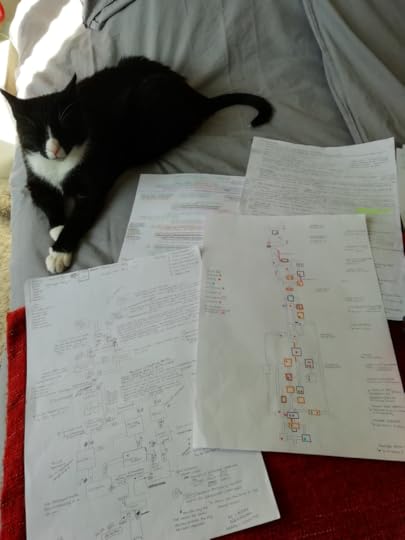
Balance is key for the reader’s experience. Think about the format of any computer game you’ve played, and you’ll realise it probably goes a little like: Exposition/cutscene > Explore > Fight > Explore > Fight > Cutscene/exposition. Variety is the spice of life, so you can review your layout and make sure that it isn’t simply one conversation after another to access the information. I often use colour to show where conversations, puzzles and found objects are placed — that quickly highlights if the gameplay will get too bogged down in one format. And finally, you should plot out the correct path(s) to confirm that readers can access all that they need in order to succeed.
Step 5: Just Get On With it!
At this point, it’s usually good to start writing. I know you’ve now identified a lot of things that need to go in, but, for now, just stay with your character in their opening scene. Where are they? What’s happening? And crucially, what do they do next? Hopefully, step 1 has created the world in your own head, so you can imagine the protagonist there and how they interact within it. From that, the choices arise quite naturally. Nightshift was the easiest one for me as it literally was the hospital I worked in. I have crept along those same corridors at night, albeit not being chased by an assassin…
Choices based on where to go next (turn left, turn right) are sometimes necessary but don’t go overboard with them. Again, aim for variety and make sure the decisions are logical and meaningful. As you have the key points plotted, you may feel tempted to go quickly from one event to the next but remember to keep showing the world. Simply walking along a corridor could be an opportunity to create the atmosphere — spooky, desolate, tense — which allows readers to feel that they are immersed in this place.
Step 6: Turn to?
What about the numbers? When you get to the end of a section, how do you know which numbers to choose? Well, I have my trusty chart of numbers and I pick a random one, highlight it to show that I’ve used it and that’s it! If I later decide that I need a certain number as it is the answer to a riddle, but I’ve already used it, I swap them. I’m now on my 7th gamebook and this has always worked for me, but there is some more advice later for checking that it all links up correctly. Let’s face it — that is pretty important! Otherwise, I am back to good ol’ pen and paper…
Step 7: Facing the Consequences
As the story unfolds, you will need to make sure that readers face the consequences of their actions. There is, after all, no point in having choices if they don’t actually matter. You could use:
· Codewords (if you have ticked SHARDS, turn to…)
· Simple statements (if you have an ivory dagger, turn to…)
· Numbers found on or associated with previous events (go to the section number that was engraved on the key/add the number that the witch told you to this section number)
· Word conversions (convert the name to a number, using the code A=1, B=2 etc)
You don’t have to use these mechanisms, although it probably would result in a lot of similar sections and therefore, a not-very streamlined book.
Step 8: Keeping Track of It All
As I mentioned, you don’t need fancy software to help you to keep track of numbers, orphan sections or dead ends. That said, some savvy formatting can help enormously. Apologies for Mac users at this stage — I only work with Windows and Word, so here goes.
With your pristine, blank document, set up the Styles of ‘Normal’ and ‘Heading 1’ to be whatever takes your fancy. When you are writing, use Normal for almost everything and Heading 1 for the actual section numbers. That’s already saved you a huge job of setting up Bookmarks later! Because Word recognises Heading 1, you can now easily hyperlink all your ‘turn to…’ And why is that worth all your time and effort, especially if you’re not planning on an eBook release? Well, it enables you to check that each ‘turn to’ does indeed go to the right place and while you’re doing that, you can also use ctrl+F to check the sections that lead to it are correct.
It might seem a bit much, but this belt and braces approach will help to pick up on mistakes, plus you can never have too many opportunities to proofread and find those typos. Because they will be lurking!
I also use Twine for the end-stage check process. By simply copy and pasting the text in, you can play through the entire game. I find this helps to check the flow from section to section — does it seem to jump too much or is there unnecessary repetition? And if I can use Twine, then anyone can!
One of the things I enjoy about writing gamebooks is the evolution. I feel like I’m adding layer upon layer to the story and I fluctuate constantly between these stages — sometimes, altering the layout, sometimes realising that I need to provide specific information, sometimes just developing more atmosphere.
I knew early on that I needed to curtail the number of wards in the hospital in Nightshift, so I had a corridor that was blocked. But only when I/’you’ crept along the corridor, did I picture a huge barrier made of skin. And only then did it occur to me that a natural decision would be to try to break through it, so I offered that as a choice, but, of course, made it impossible. However, the attempt was a perfect opportunity to add in yet another horrible experience. And then much later, once I’d written about a certain entity, I went back to the skin and included tattoos that reference the entity. The end result looks like a rich and well-thought-out section, but it only happened piecemeal and with repeated play-throughs — it absolutely wasn’t there from the start. So, have a little faith in yourself that, with a little space and time, the layers will go on and your story will come together.
January 21, 2023
Behind the Scenes: The Phantom Self
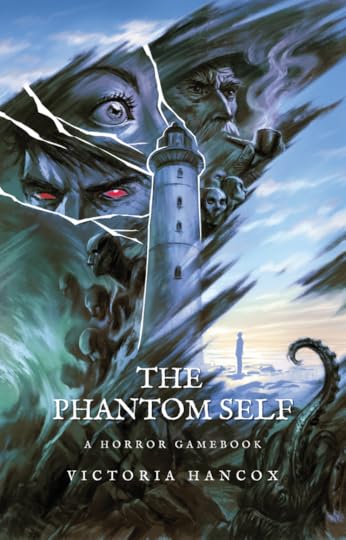
It’s not easy to write about The Phantom Self, as the main challenge in the book is to work out what’s going on! But I’ll try to skirt around the edges without giving too much away!
I’ve always been fascinated by the notion of parallel universes, multiverses and doppelgängers and had been toying with a story based on that for a while. In fact, the original, non-interactive version of Nightshift had parallel universes as its big reveal, but the least said about that the better…
In addition to doubles and parallel worlds, The Phantom Self is based on one of my great fears, which is not knowing what is real. It’s something that we all take for granted, but when I did my nurse training placement in a mental health unit, I realised that some people are living with very real (to them) experiences, whilst everyone around is telling them it’s not so. How frightening would that be? What do you believe? Who do you trust? And I also have a very specific nightmare of someone simply disappearing — one second, they’re there, the next gone — and what if you asked for help, but it was as though the person never existed and you’d never been seen together? The prospect makes me shudder!
Films like ‘Triangle’ and ‘Time Crimes’ were inspirations (and I highly recommend both), but the biggest influence was an obscure British TV drama from the late 80s about a woman who went to stay in a B&B, where her boyfriend mysteriously vanished. I have absolutely no idea what it was called and have tried and failed to track in down, but I ‘borrowed’ elements from one of the scenes and that appears in the Games Room in the Ankou Field Studies Centre.
The characters were not based on anyone real, but all their names were picked to tie in with the theme. For example, Fetch and Vardøger are doppelgängers; Parsimony relates to Occam’s razor; Everett was a scientist who researched multiverses, and Erwin is the first name of Schrödinger — yes, that ‘alive and dead cat in a box’ experiment.
And that brings us to the poor calico cat. You may be wondering why the feline got trapped in the chest, where it died a tortured and horrific death. You might be suspicious about the scratches all over your arms, although you couldn’t remember where you got them from. Maybe you saw the night vision camera footage, which told you how but not why…
Unfortunately, I’m not going to give you any answers here either, but book 6 — ‘Game Over’ will reveal all! However, I can put one rumour out of its misery, by telling you that the Calico Cat wasn’t Charpentier. He returns, alive and well and in all his sardonic glory in the final.
The room names: Puffin, Kittiwake, Gannet and Guillemot are simply sea birds, but some have suggested that it stems from a homage to Puffin Books, as they were the publishers of the Fighting Fantasy books. Not true! When I was 11 or 12, my family went on holiday to Anglesey, Wales, and on a beach, I found a skeleton of a puffin, complete with its beautiful, multicoloured beak. My Dad took the beak and mounted it in clear resin as a keepsake. Which is not the typical father-daughter relationship, I agree, but perhaps that’s why I’m drawn to more ghoulish things…
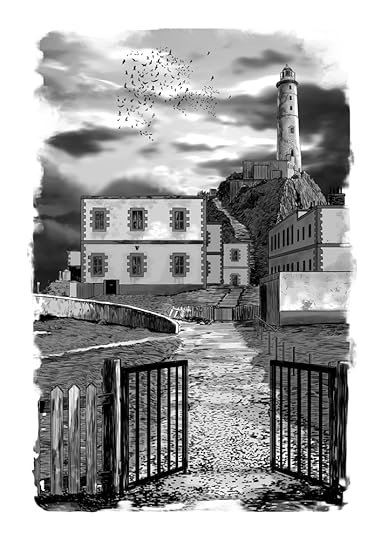
Talking of Wales, the Ankou Field Studies Centre was based on a real location. I visited an Environmental Field Studies Centre in Pembrokeshire, on the south-west coast, for my Biology ‘A’ level, although there was no cave or cuttlefish nearby. Otherwise, The Phantom Self has no real-life experiences or events that I wove into the story. It all developed organically from placing someone in a weird, horrific situation, then letting them react.
And if that sounds simple, it was actually a nightmare to write. I had a mass of A3 papers sprawled all over the floor, as I tried to keep track of all the various happenings on each day you were at Fetch’s Point. I wanted readers to have those moments of realisation, when they figured out, step-by-step, what was going on as the saga unfolds, so I needed to be very careful in making sure all the clues were there.
If that wasn’t enough, The Phantom Self is book 3 in The Cluster of Echoes and needed to tie in with the others, too. So, did anyone meet Otto? He was working with Parsimony but left to go for an interview with a certain Bio-Imperium… Yes, if you head to the library in The Alchemist’s Folly, you will meet Otto again and find out how his new career choice is working out for him. And that’s not the last you see of Otto, as he has a cameo in Shopping Maul!
Talking of Shopping Maul, you might have found the newspaper ‘Douglas Herald’ in the lighthouse, which had the story about a genius schoolgirl taking part in the Golden Hare Treasure Hunt. And if you were successful at Fetch’s Point, you found out that Occam’s Occult Investigations were going off to the next case at a hospital — yes, Nightshift is also in the same universe!
I always enjoy writing different death or end scenes, but my favourite was “…you simply sit on the stone floor and cease to exist. At this moment in time, it’s probably the most logical thing to do.” It made me laugh because it really summed up just how confused you might be at this stage.
Finally, I did love the ‘turn to 300’ ending. NO SPOILERS HERE, but there were three ways that you could succeed, and I liked that, while it might feel counter-intuitive or just plain wrong, it nevertheless aligned with the themes. Plus, there was a pretty big and unequivocal clue that told you exactly what to do, if you only found and followed it…
The Phantom Self was updated in December 2022 with a new cover and interior illustrations. The hardback edition has the puzzle solutions and lots of juicy background stuff, plus a little side note on the fate of Occam's Occult Investigations...
November 20, 2021
Paulson’s Peak — A Masterclass in Gamebook Writing!
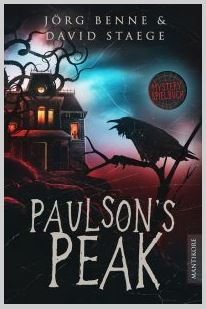
This gem was published back in March by Mantikore, and so far is only available in German, but hopefully, they soon realise what a huge market of gamebook aficionados could be reached by translating it. Fingers crossed!
The premise is that ‘you’ have been invited to an empty, old mansion by your friend, Sid. The past owner liked to invent ‘Toybots’ and had a tragic history with his wife dying young and the strange disappearance of his maid. Seeing as the mansion, the eponymous Paulson’s Peak, sits on a cliff edge, it will soon be lost to the sea as the ground erodes underneath it, so this is the last opportunity to discover some of its secrets. Especially why it still consumes such a large amount of electricity despite no one living there…
Is there a hidden room?
And who doesn’t love a ‘find the secret room’ story? Gamebooks should have a solid end-goal and a robust tale to hang the gameplay on — Paulson’s Peak delivers this in spades, with a gradually revealed back-story that allows you to discover the truth about Henry Paulson. But of course, we came here for the gameplay and here is where Jörg Benne has excelled.
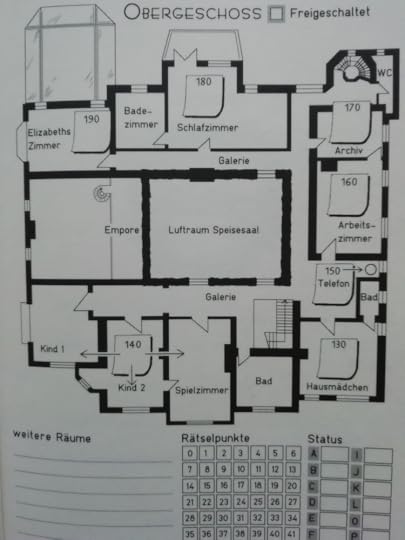
Most of the book is based around the floor plan of the mansion. Each room has its own number — so if you want to visit the bedroom, you turn to 180 — and it’s completely up to you in which order you explore the mansion. Initially, you are limited to the lower floor, but after a pinch point, the upstairs is opened up too. This gives it a more ‘Escape Room’ vibe and definitely gives the reader more autonomy with the game. It also places the onus on the reader to be on the ball! Instead of gently leading you through the story, as more linear books do, it simply sits back and says, ‘So where do you want to go next?’ For example, one of the first rooms I went into was the guest room en-suite, in which I was told that there was nothing much here, unless I had status A2. Naturally, I hadn’t — I’d only just started — but much, much later, I found a dirty object (no spoilers, don’t worry) which triggered me to update A’s status to 2. It was totally my responsibility to recall that A2 was used in the guest bathroom and when I went back, lo and behold, there was a brush that I could clean the object with.
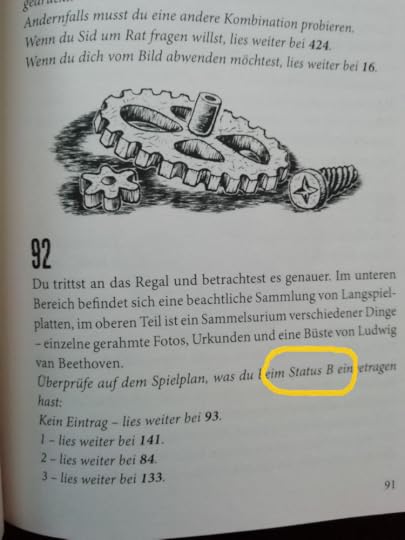
Part of the joy with Paulson’s Peak is that it evolves with your own unique pathway through the story. The main mechanics are the alteration of the room number once you’ve achieved something significant in the room AND the status check boxes. With these, you can track the discoveries and subsequent actions taken, such as looking at the bookcase (B0), finding a lock behind some items on a shelf (B1), then finding the key (B2), then using a chisel to open the warped, secret door that you've just unlocked (B3). Each of these steps might require you to go away to different rooms to find the key and the chisel, but the updated statuses allow you to return to both the room and a logical place in the story, rather than rehashing the same sections.
And hopefully, I’ve not made it sound complicated, because it's not. It's really easy to navigate. The record sheets are in place and you are clearly instructed when and how to make alterations to the floor plan and statuses.

So not complicated but definitely challenging. It’s jam-packed with an inventive array of puzzles — indeed, there’s one I still haven’t managed to work out — but there are clues to be found all around which nudge you in the right direction, although again, you are left to your own devices to make the connections. This book makes you work for each success! And if that fails, the character, Sid, can act as a walkaround. Often, he can be called upon to work it out for you, but naturally, this is at the expense of losing points, so there's a limited amount of times you can do this! You have to choose your battles wisely...
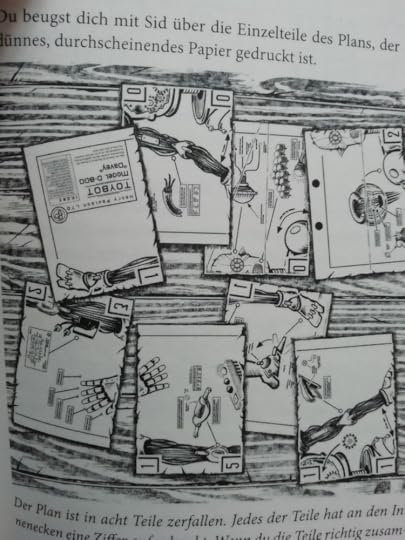
There’s plenty of excellent visuals in this book too — clues are found (or missed, if you scan it too quickly like I did!) in the sketches of desks and drawers, so a nod must go to the artist, David Staege.
Paulson’s Peak is a clever gamebook that hooks you, reels you in and doesn’t let go until the last puzzle is solved and the last page is turned. It leaves you feeling a great sense of achievement and satisfaction when you’ve finally finished the exploration.
And yes, I did find the secret room and the reason for the excessive electrical consumption, but I’m not telling you…
February 18, 2021
Behind the Scenes: The Alchemist's Folly
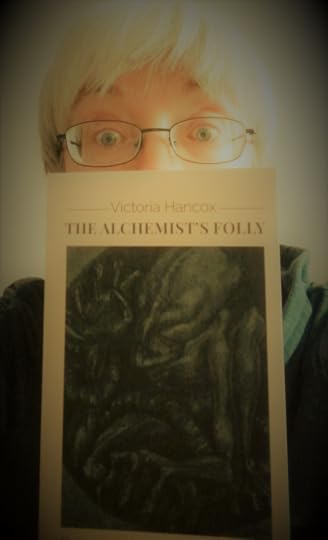
Whilst it may seem at first glance that The Alchemist’s Folly has an anti-science message, my objection is actually to scientific advances being hijacked for nefarious purposes. It’s not so much that science itself is the problem, but what humanity does with it. Hence the quote from ‘Jurassic Park’ at the beginning of the book (my absolute favourite film and I’m not ashamed to admit it. Well, maybe a little bit…) So Alchemist’s Folly is basically about people being the real monsters.
Obviously, this goes against the grain a little. After all, in Fighting Fantasy, the arch-nemesis is a Snow Witch, Lizard King or warlock, but with Nightshift’s big baddie being a demon, I wanted to try something new. With that, my inner misanthrope gave an evil smile, started plotting and the power-crazy humans who inhabit the Folly were conceived. Welcome to Bio-Imperium!
I like using names as foreshadowing or for cohesion, and it all starts with Bio-Imperium: Latin for control of life, which is exactly what the genetics company is trying to do. The characters’ names are no accident either but first, a little history of alchemy is needed. The raison d’être for alchemists was to produce the Philosopher’s Stone, so they could change base metals into gold. The chemical process — their Magnum Opus — changes the substance’s colour from black (nigredo) to white (albedo) to yellow (citrinitas) then finally, if the experiment is successful, red (rubedo). Which is why the CEO of Bio-Imperium is called Professor Rubedo. For a long time, the clone was named Dr Citrinitas, as he was second in line to the professor, but it felt clunky and difficult to pronounce, so I changed it to Cinnabar. Yes, that is Bloodbones’ name but it’s also the old-fashioned name for the compound mercury sulphide, which just so happens to be substance that you make for the elixir. And yes, mercury sulphide is toxic but it wouldn’t kill that quickly in reality.
Talking of red, black, white and yellow, those are the colours that the four doors in the gallery are painted, and to be honest, that only came about late in the writing when it was threatening to snowball out of all proportion. You can enter the gallery by three of the doors and, at first, I had it that you could exit through the “opposite door or the one on your left…” This meant I had duplicate sections and it just got too complicated. Having the doors identified by colour rather than their relative position made life a lot simpler! And sticking with rooms, surely everyone got that the house was based around Cluedo. Although the Hall is missing, there is a ballroom, library, kitchen, lounge, conservatory, billiard room, dining room and the escape room at the start is the study. This is referenced when you are in the library and mutter “Colonel bloody Mustard” after you’ve knocked the candlestick over. And on a side note, the escape room part was initially much bigger with 4 puzzles to solve in order to leave. In the end though, I wanted the story to get moving a bit quicker, so I hacked it down. Sometimes, you’ve just got to be ruthless.
There are 4 possible endings, although they have varying degrees of success and even in the GOLD ending, you don’t leave as a true champion. I wrote ‘you’ as being cut-throat and self-centred, so I really wanted to give the protagonist an ambiguous ending — again, bucking the trend of many gamebooks where you are the hero! Not sure if that went down too well, but it was something else I wanted to try out.
Other homages to mention were:
· Spirals — thanks to the double helix of DNA, there is the exterior staircase of the folly, the spiral staircase leading up to the attic and the nautilus shell tattoo on the electrocuted test victim.
· Henrietta Lacks — in section 139, you pass by a large rune and part of its inscription reads “Behold the line of cells that lack/immortality to the cursed.” Henrietta Lacks died of cervical cancer in 1951, but her tumour cells were cultured and became an immortal cell line (HeLa). Professor Rubedo is said to have died of lung cancer and the lovely broth of cultured cancer cells is all that is left of him.
· Evolution — Darwin developed his theory from observing different beaks on the finches from different environments in the Galapagas Islands, which is why the Dr Cinnabars all have different nose shapes. By the time, I got to the appearance of the last Cinnabar clone, I was really struggling to come up with a new nose description!
The experiments and conditions are mostly taken from real-life. CATDOG was originally done in the 1950s by Vladimir Demikhov, although he used adult dogs with puppy heads sewn on. The test room experiment is a classic psychological experiment by Stanley Milgram and the goat-wasp-prion is a hybrid of 2 experiments/discoveries. The first is an experiment with spider silk genes which you read about in the platform waiting room. The second is the recently discovered Zatypota wasp which lays its eggs on a spider. The larva then produce a substance which controls the spider, making it create a strong web for them. Once that job is done, the larva feed on the spider before tucking themselves up inside their cocoons — you see this in action in the garden where the hives are. By mixing these two up together, I came up with the Zombie disease. Having it spread via goat’s cheese just tickled me, and I liked the idea of the clones being stumped by vegans.
For the ‘mutants’, I was inspired by the Medizinhistorisches Museum in Berlin, which has rows upon rows of human embryos. By studying their mutations, scientists could understand the process of embryonic development and the role that genetics plays in it, but you can also see how legends and folklore tales would have evolved. For example, as people in the past tried to explain a baby with only one eye in the centre of its forehead, the Cyclops myth was born. That said, the cover image is the Homunculus and that most definitely isn’t real!
I enjoyed the variety of puzzles in the Folly. They emerged with the situations, so there is the maze walkthrough at the actual maze; the odd-one-out portrait in the Artist’s Room, snooker balls and the ethernet cable logic problem in the Server room. I also liked that the modern world was brought into the book with viral YouTube videos, WhatsApp, PIN and decontamination showers. It was a nice juxtaposition against the Roman mythology and alchemical elixirs.
And finally, did anyone notice the mention of Charpentier’s veterinary appointment? Charpentier was the talking, occasionally helpful cat that you may have met in Nightshift. This was the first clue that Nightshift and The Alchemist’s Folly are set in the same world and more is revealed in The Phantom Self. Especially if you went to the library and met Otto the Failed Applicant…
July 21, 2020
Choosing the right route? Interactive fiction vs gamebooks The Wandering - a (kind of) review.
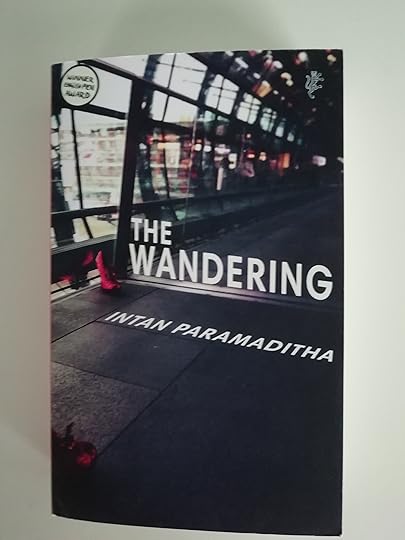
There are times when I'm thinking of different puzzles to put into my gamebooks and I wonder: what if I just didn't. OK, to even dream about being designated a 'gamebook' it has to have some game-like devices, so having puzzles to work out and clues to find are integral and part of the challenge.
That said, it is all a bit forced, isn't it? Having to work out riddles to 'prove your worth'? Or knowing specific pieces of information because you just so happened to take a particular path? Sometimes the story has to be tweaked in order to justify the presence of a puzzle and that makes me question whether it's the right approach. Surely the story should reign supreme? Or am I just overthinking the whole thing and I should simply remember that it is fantasy fiction?
I was chewing over all of this when I heard about 'The Wandering' and decided to branch out into non-gamebook IF. Long story short and without spoilers, it's about a pact with the Devil and an exploration of life choices. On my first attempt, I took off to Berlin, enjoyed a well-written story and then... put the book back on the shelf. I will return to it and see what the other stories are about but, in the meanwhile, it shone a light on what I do love about gamebooks and that is they have a purpose, a goal. The whole 'turn to 400' and getting to the final chapter is the reason why you go back again and again to explore all the paths. Conversely, The Wandering didn't have a quest with an ultimate endgame; its purpose was to savour the journeys, not necessarily to reach a destination, but is that what I wanted? As the book sits there gathering dust, the answer to that question is quite clearly 'NO'.
Maybe I'm biased. Maybe I've just been brainwashed with Fighting Fantasy from my childhood but it made me realise that what's important for me in IF is resolution. I'm OK with taking all these different routes, but only if they have a purpose; if they add layers to the story and if they take you to a singular endpoint.
Once I've actually read all of The Wandering, I'll update this with an apology if it does all come together in one glorious final chapter, but the point is, that it didn't feel like it was going to do that and that's why I paused.
For me, all the strands of IF need to be tied up by the end and so for now, I guess my puzzles stay.
But I'm open to recommendations, so let me know if there are other IF stories that could give me a different perspective on it.
June 7, 2020
Behind the Scenes on the NIGHTSHIFT
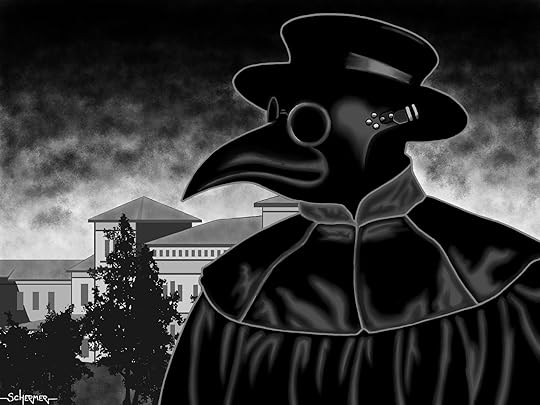
Believe it or not, there is a method to the madness and most people or objects that you encounter during the Nightshift, have been chosen for a reason. Read on for foreshadowing, historical events and, of course, SPOILERS!
But before we start, the image is by the talented artist TroyAnthony Schermer. There is just something about plague doctors, isn't there? Even though he's such a small cameo in the story, it was blindingly obvious that he would be the cover star - no-one else would do! - and it's fantastic to have this incarnation of him.
Let’s start with the knives. The athame knife is a real item in witchcraft and is used for pagan rituals with its traditional black handle. In Nightshift, you may also find the white handled boline knife in the macerator. Later on, you hear the two ghost nurses arguing about which coloured handle knife is needed to ‘off him’. Seeing as the boline knife is commonly used for preparing herbs, I couldn’t have used that as the weapon to defeat Carmichael, but that’s the reason why it has crushed basil on the blade, as you discover if you end up in the pit.
Talking of colours, the black and white theme rears its head a few times. Other than the knives, there are:
· The two children in the playroom – like chess pieces, one is jet-black and the other is snow-white.
· The smoke that rises from your spell to destroy Jezebeth
Another theme is that of puppets, with the blood of the puppet master needed for your spell; the torn-out baby is actually a marionette; if you don’t beat Jezebeth, then she climbs inside your skin and takes you over, and Carmichael thinks he in charge but really it’s Jezebeth who’s pulling the strings.
And whilst we’re on the subject of Jezebeth, this is the name for a demon of falsehoods, although her origins are not so clear. She’s snake-like because, let’s face it, that’s scary looking and it also links to the Bowl of Hygieia. This is the symbol of the pharmacy – yes, that’s where the final battle happens – and is a snake coiled around a chalice. Obviously, snakes have a bad reputation throughout literature and religion as being liars and generally evil, so it fitted well with Jezebeth. Plus, the ‘child’ you meet is one of the demon’s entourage and turns into a snake; there is a braided snake skin bracelet in the cafeteria and the Ouroboros symbol in ITU, not only is a snake but it also foreshadows Jezebeth’s eventual destruction by eating herself out of existence.
Other names in Nightshift are:
Alice Nutter – a real woman accused of and hanged for witchcraft in Pendle, Lancashire, 1612.
Hecate – the Goddess of witchcraft in Greek mythology
Jinny the witch – she has many names in folklore but is usually with green skin, sharp teeth and near water. She’s always evil, hence you find her at the swimming pool and it doesn’t end well!
Empusa – she has different interpretations and also comes from Greek mythology, but common traits are being related to Hecate, sucking blood and having one leg. Like you do…
Erichtho – She was my second favourite witch (first one was the charred witch in A + E) and comes from Thessalian literature. Her main defining feature is being horrifically repugnant and a necromancer, so it was an easy choice to have her stolen power as the ability to resurrect the dead.
As a rule, the array of witches have mostly been killed by drowning (Geriatrics), burning (A + E) or hanging (Psychiatrics) to reflect real-life experiences of the women accused of practising witchcraft over the centuries.
Baigujing – is a Chinese shapeshifting demon and is normally depicted as a skeleton, so I placed the passageway that she tells you to use in the fracture room. Clearly though, taking advice from a demon is not a wise move…
However, this is foreshadowed by the skin barrier. There are 3 things seen there and ‘Beware of foxes and Baigujing’ was a clue to not trust the French women in the shop who is holding a cuddly fox. The gossamer fairy was a nod towards the tiny creature in the mirror microscope who is acting out how to take someone’s dying breath (which comes in handy only a few moves later) and finally, a German error. In the first edition it reads ‘Mein Haut ist mein Grimoire’ – my skin is my book of spells – but I’ve got a mental block with Haut and always want it to be a neutral noun. It’s not; it should be meine Haut. I swear, German is the hardest language to learn!
Anyhow, back to dying breath. The codeword for that was CHEYNE STOKES – which is the actual term for the disordered breathing that can happen when someone is dying – and the codeword GLOSSAL comes from the Greek word for tongue or language. Which is useful when you need to talk to crows.
One of my favourite characters was Charpentier the cat. He behaved in exactly the way you’d expect of any cat that can talk. The name though is derived from the chemist Paul Charpentier. He created the drug, promethazine, which is an early antihistamine and if anyone has had these drugs – Piriton is another one – you’ll know just how sleepy they can make you. That’s why they’re often used as a pre-med too. And where is Charpentier the cat working? The sleep laboratory…
A more obvious link for the sleep lab was its flower name: ‘Poppy Ward’. It was a short and simple skip from the poppy fields in The Wizard of Oz to opium to sleepiness.
And finally, the newspaper crossword puzzle – it was published on Nov 9th, 1888, which may seem like a random date from the Victorian era, but it has much more notoriety than that. Mary Kelly was murdered in Whitechapel on this day and seeing as Nightshift is about a Victorian serial killer who targets women and takes their organs away, who better to reference than Jack the Ripper.
That’s not all but it feels that an appropriate place to wrap it up for now! Sweet dreams!



